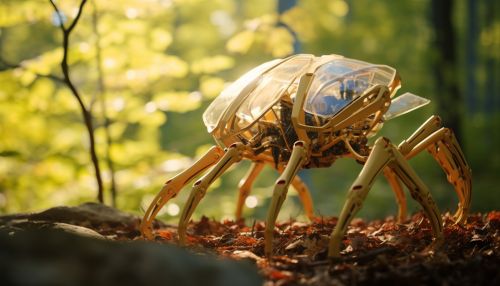Biomimicry in Robotics
Introduction
Biomimicry, or biomimetics, is the emulation of the models, systems, and elements of nature for the purpose of solving complex human problems. In the field of robotics, biomimicry is used to develop robots that can perform tasks in ways similar to living organisms. This approach is based on the idea that nature, with its billions of years of evolution, has already solved many of the problems we are grappling with today. Animals, plants, and microbes are the consummate engineers, and they have much to teach us.


Principles of Biomimicry
Biomimicry in robotics is based on three fundamental principles:
- Nature as a model: Biomimicry studies nature's models and emulates these forms, processes, systems, and strategies to solve human problems.
- Nature as a measure: Biomimicry uses an ecological standard to judge the rightness of our innovations.
- Nature as a mentor: Biomimicry is a new way of viewing and valuing nature. It introduces an era based not on what we can extract from the natural world, but what we can learn from it.
Applications of Biomimicry in Robotics
Biomimicry has been applied in various fields of robotics, leading to the development of robots that mimic the movements and behaviors of animals, insects, and even plants. These robots are designed to perform tasks in environments and conditions that are challenging for humans or traditional robots.
Bio-inspired Locomotion
One of the most common applications of biomimicry in robotics is in the development of robots with bio-inspired locomotion. These robots mimic the movements of animals and insects to move efficiently in various environments. For example, the Boston Dynamics' "Cheetah" robot is designed to run and jump like a cheetah, the fastest land animal. Similarly, the "AquaPenguin" developed by Festo uses a propulsion system that mimics the way penguins swim.
Bio-inspired Sensing
Biomimicry is also used in the development of robots with bio-inspired sensing capabilities. These robots mimic the sensory systems of animals and insects to perceive their environment and respond to stimuli. For example, the "RoboBee" developed by Harvard University uses artificial compound eyes to mimic the vision of bees. Similarly, the "RoboBat" developed by Brown University uses echolocation to navigate in the dark, just like bats.
Bio-inspired Manipulation
Biomimicry is also applied in the development of robots with bio-inspired manipulation capabilities. These robots mimic the ways animals and insects manipulate objects to perform tasks. For example, the "OctopusGripper" developed by Festo uses tentacle-like structures to grasp and hold objects, just like an octopus. Similarly, the "RoboRaven" developed by University of Maryland uses articulated wings to perform aerial maneuvers, just like a raven.
Advantages and Challenges
Biomimicry offers several advantages in the field of robotics. It allows for the development of robots that can perform tasks more efficiently, effectively, and safely. It also promotes sustainability by encouraging the use of materials and energy in ways that are in harmony with nature.
However, biomimicry also presents several challenges. It requires a deep understanding of biological systems and their underlying principles. It also requires advanced technologies to emulate these systems and principles in robots. Furthermore, it raises ethical and legal issues related to the use of biological models and the potential impacts on biodiversity.
Future of Biomimicry in Robotics
The future of biomimicry in robotics looks promising. With advances in technology and a growing understanding of biological systems, we can expect to see more robots that mimic the movements, behaviors, and sensory systems of animals, insects, and plants. These robots will not only perform tasks more efficiently, effectively, and safely, but also inspire us to view and value nature in new ways.
